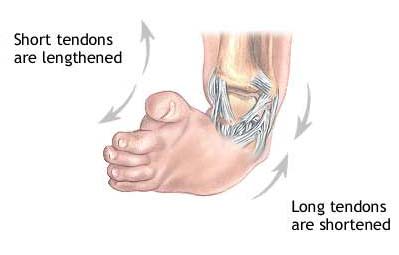

 |
|
| What is clubfoot? | |
|
Clubfoot is a deformity of the foot which occurs at
birth or during childhood. It is also known as "talipes equino varus"
which comes from latin. "Talipes" is derived from the word meaning
"ankle bone" and "pes" means "foot," thus describing the location of the
abnormality. "Equinus" means "horse" and is used in this context to
describe how children affected with a clubfoot walk on their toes with
the foot pointed downward, analogous to how horses walk on their
toenails. Therefore, a child with clubfoot has abnormal posturing of the
foot which causes him or her to turn the ankle inward and walk along the
outside edge of the foot. The word, "club," is also used to describe the
appearance of the foot. |
|
| What causes clubfoot? | |
| There are two categories of clubfoot.
The first and most severe type is associated with other congenital (or
genetic) abnormalities or problems occurring when the fetus is inside
the mother's uterus. These include neurogenic conditions (spinal
dysraphism, tethered cord, arthrogyrposis), connective tissue disorders
(Larsen's syndrome, diastrophic dwarfism), and mechanical conditions (oligohydramnios,
or congenital constriction bands) which are beyond the scope of this
patient guide. The second type of clubfoot is less severe and is called "idiopathic" which means "of unknown cause." Treatment of children in this group tends to be more successful. |
|
| How do I know if my child has clubfoot? | |
| Clubfoot is often noticed by physicians caring for a baby when it is first born. The things to look for are as described above: a foot that is flexed and turned inward. If not corrected in infancy, a parent might later find the baby walking on the outside of the foot. Again, there may be atrophy (or decrease in size) of the calf muscles and the affected foot may be be up to 1 cm shorter than the normal side. Pediatric Orthopaedic Surgeons can pick up on even small abnormalities in the foot anatomy. | |
| How is clubfoot treated? | |
| Casting It is very important to treat clubfoot and do so as early as possible (i.e. shortly after birth) to prevent disability and problems with walking when the child gets older. Clubfoot can be treated so that the deformity is corrected and normal function, for the most part, is restored. The first step in management is taping or casting of the foot. The physician holds the foot in the proper position and then puts tape or cast on to hold it in place. One-third of feet, usually the ones more mildly affected, will respond to this therapy. During the immediate postnatal period, the cast or tapings are changed every day. Thereafter, your child will be seen frequently by the pediatric orthopedic surgeon: every one to two weeks. Initial treatment is provided by a series of casts to the affected foot (feet). Infants are placed in casts covering the entire limb(s). The severity of your child's deformity will determine the number of casts required. In more severe cases, your child may also require tendon lengthening or surgical correction. Most daily activities are not hampered by cast wear. Bathing is one exception. Your baby will, in most cases, not be able to be dipped into water. The casts will need to be kept dry. Diaper changing is not altered. After multiple serial castings are completed (2-3 months), special shoes with or without a bar may be needed. |
|
| Surgery If cast treatment fails, surgery may be necessary. This is not performed until the child is at least 4 to 8 months of age, and in some cases may be deferred until the child is 3 to 5 years of age. The Pediatric Orthopaedic Surgeon lengthens or releases several of the tendons (structures which connect muscle to bone) which allows to foot to adopt a normal position. This may also be accomplished with a tendon transfer. |
 |
| Is there any treatment needed to prevent the clubfoot from coming back? | |
| Whether correction is accomplished by casting or by operative therapy, splinting at night may be used to prevent a recurrence of the deformity. Corrective shoes have little benefit in preventing recurrence and thus normal shoes are allowed during the day. Exercises too are insufficient as the only treatment for recurrence, but some believe that stretching may be of some benefit. | |
| Will my child need to continue to see the doctor after treatment? | |
| Children need regular follow-up for several years after treatment (casting or surgery) to make sure that the clubfoot does not come back. The idiopathic type (i.e. the cause is unknown) clubfoot can come back up to about six or seven years of age. Most, however, if they do return will do so within several years of treatment. Repeat casting or further surgery can be performed. | |
| What are the chances that my child's clubfoot will get better? | |
| With adequate treatment, it is very likely that the deformity can be corrected and that your child will be able to walk well on the affected foot. Some elements of the deformity, however, may never go away. this includes the smallness of the foot, the small calf muscles, and the shortening of certain tendon. These rarely change a child's overall functional ability. | |
| Clubfoot overview information courtesy of The Department of Orthopaedic Surgery - Johns Hopkins Medicine | |